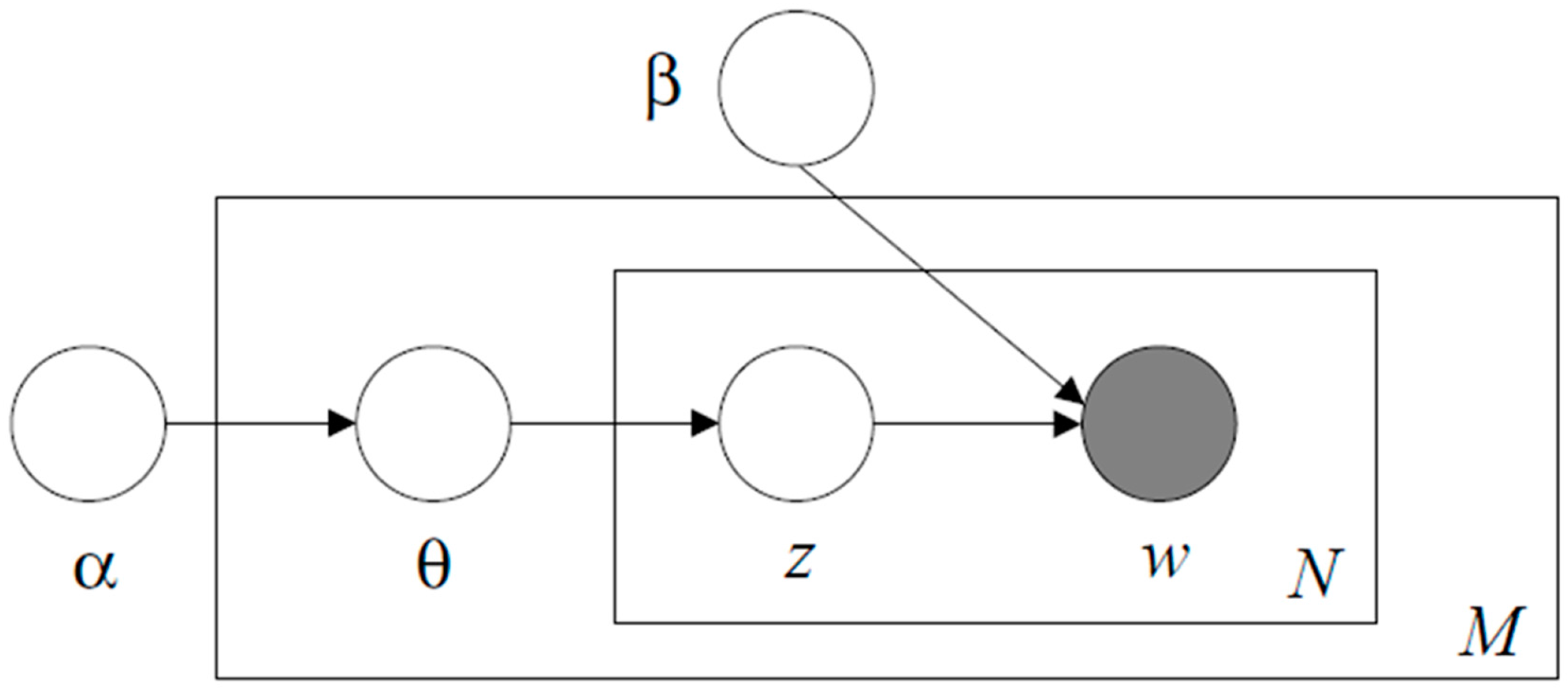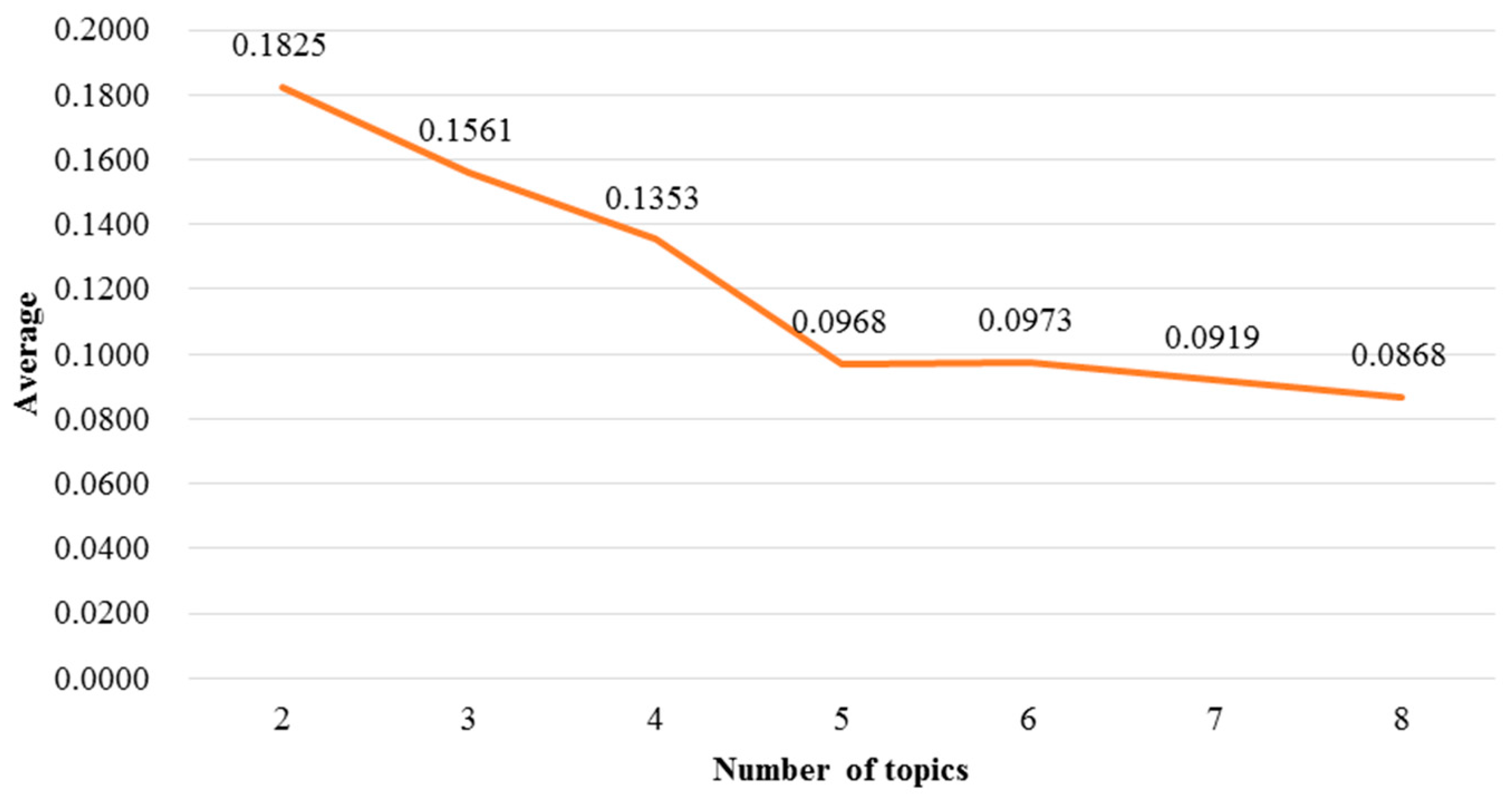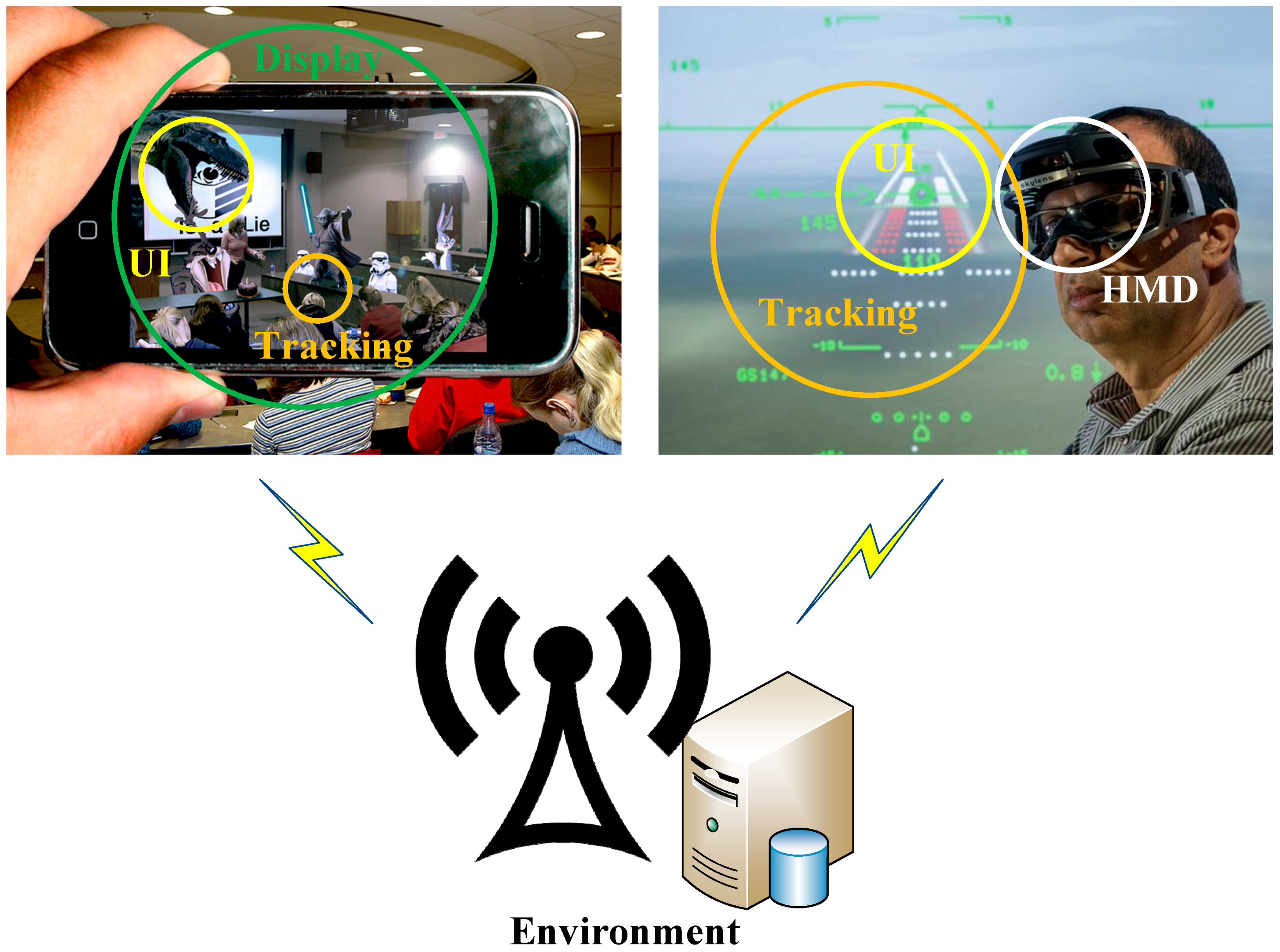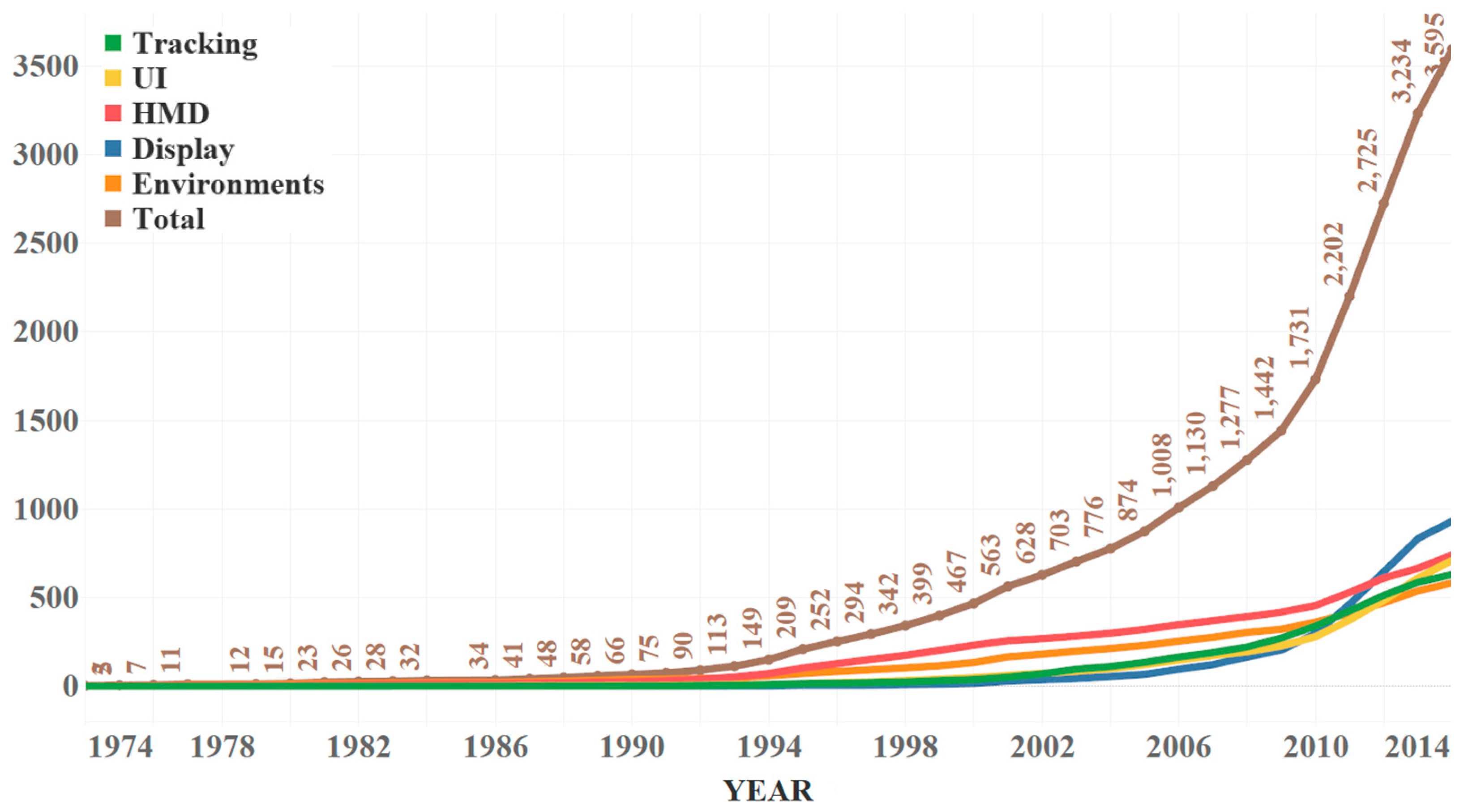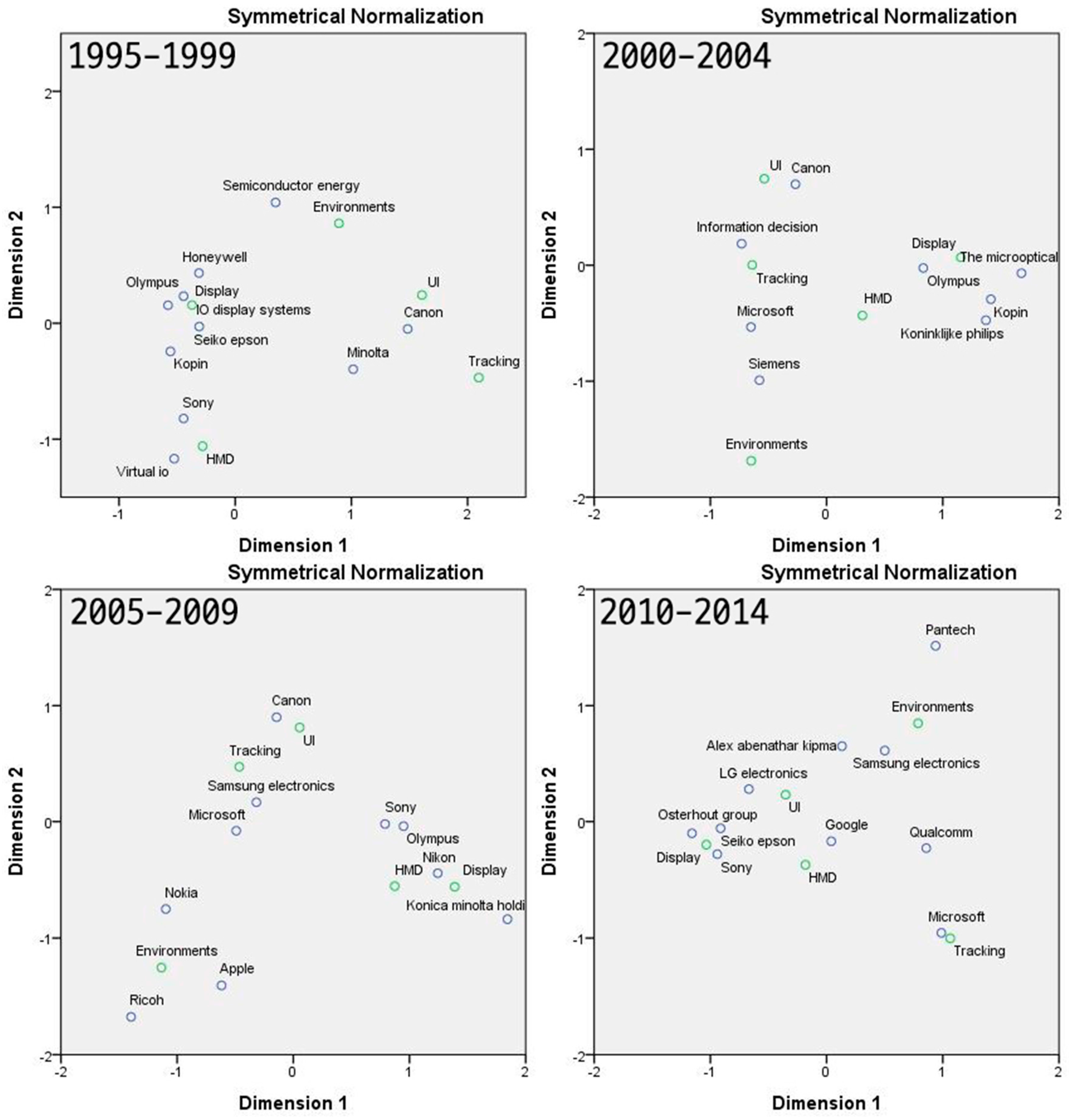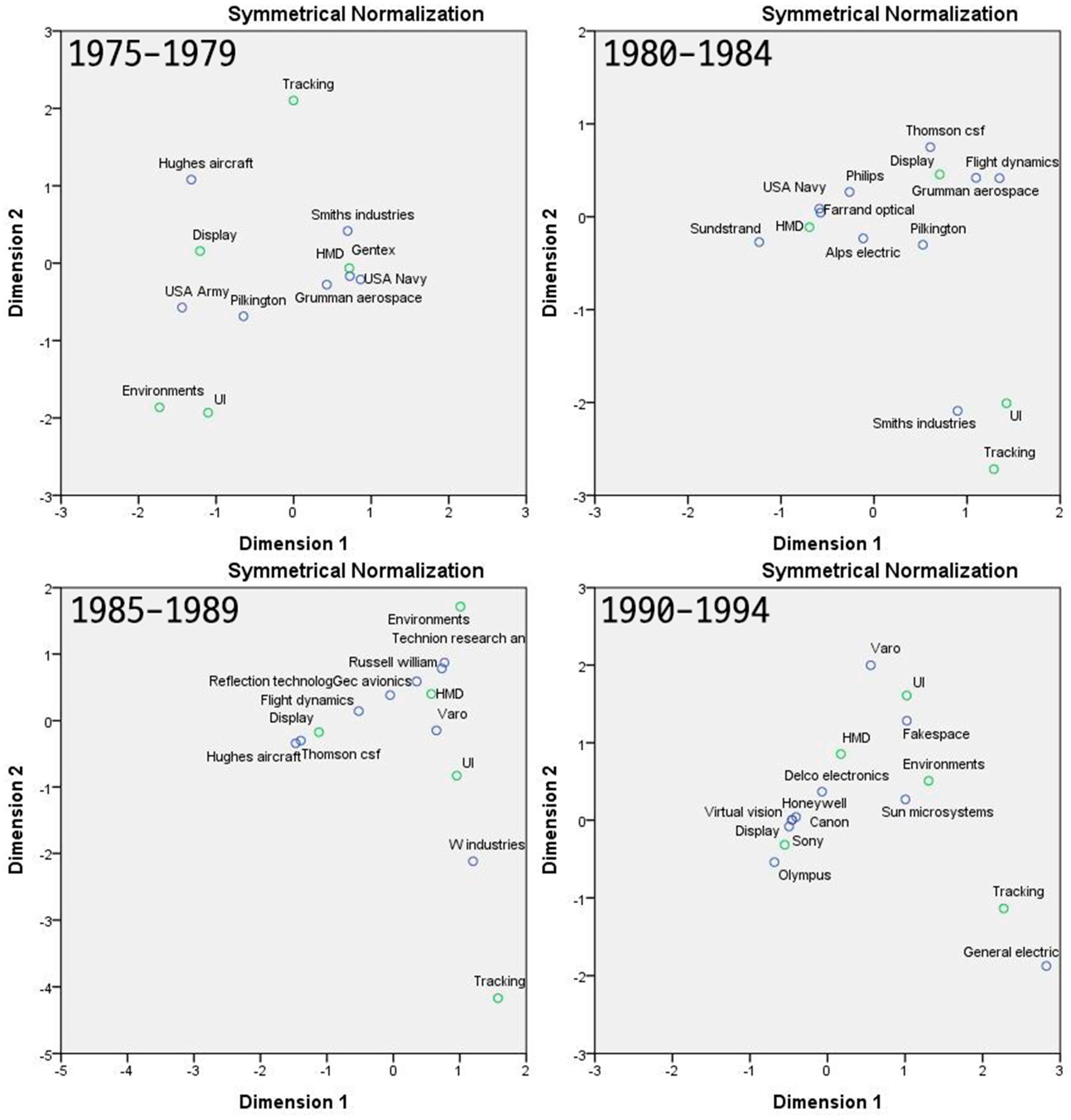This section explains the process and results of competitive intelligence analysis in augmented reality, including technology subject determination within augmented reality by LDA approach to patents, followed by competitive intelligence analysis at the levels of technology subject and firm.
5.1. Identifying Technology Subjects in Augmented Reality Technology
The first task of our analysis is to determine the proper number of topics for LDA processing. Each of the topics identified by LDA becomes a technology subject in augmented reality and is then used as the basis to measure the TKSs for the topic and the relevant firms.
Several techniques can be used to select an appropriate number of topics, including the elbow method, information criterion method, and information theoretic method. Among these methods, the elbow method is adopted in this study, in which an optimal number of topics are determined by calculating the average cosine similarity value between pairs of patents by a different number of topics. We set the number of topics from two to eight and thereby observed the change in the average patent similarities (
Figure 4). The average cosine similarity between all pairs of patents by the number of topics showed a tendency to decrease as the number of topics increases; the average similarity decreases rapidly until the number of topics is five, but it showed a scant decrease when the number of topics are five or more. Therefore, we concluded that five is the most appropriate number of technology subjects to classify augmented reality patents.
One output of LDA application to the valid patents of augmented reality is the term-probability pairs for the five topics identified (
Table 2). Then, each topic can be interpreted as a specific technology subject within augmented reality technology by examining its major contributing terms. By comparing each topic with the technical keywords of a prior augmented reality technology classification study [
7], we examined the technology subject to which each topic technically corresponds; finally, we were able to determine the five technology subjects: tracking sensors and approaches (Tracking), user interface and interaction (UI), displays (Display), head-mounted displays (HMD), and more requirements of augmented reality (Environment).
First, the major contributing terms of Topic 1 are “image”, “object”, “camera”, “position”, “plurality”, “orientation”, “location”, “sensor”, and “target”; we were thus able to conclude that Topic 1 is semantically related to the technology subject “tracking sensors and approaches”; this technology subject contains methods for identifying the location and orientation of users or target objects using various sensors. Second, Topic 2 contains some major contributing terms, including “image”, “virtual”, “user”, “information”, “object”, “position”, “configure”, “control”, and “input”; it thus likely shows methods and devices for interaction with users. The composition of these highly contributing terms is related to the configuration and control of the interface between users and virtual environments, so we concluded that Topic 2 likely corresponds to the technology subject “user interface and interaction”. Third, Topic 3 was constructed by contributing display-related terms, such as “display”, “image”, “light”, “optical”, “eye”, “source”, “lens”, “beam”, and “axis”, so we considered Topic 3 as the technology subject “display”. In particular, we found patents in Topic 3 that address methods and apparatus used for projecting augmented environments through an optic system such as lenses and beams. Fourth, Topic 4 was considered as the technology subject “HMD”. We examined the most contributing terms of Topic 4, including “display”, “head”, “image”, “mounted”, “signal”, “eye”, “light”, “view”, and “camera”. HMD, as an apparatus to display virtual or real environments synthetically, is a device mounted on the user’s head and its display part is located in front of the user’s eyes to cover their sight. Although this topic can be considered as part of the technology subject “display” [
7], HMD is used in this study as a separate technology subject, by taking into consideration that many HMD-specialized patents have increasingly been filed and that HMD is a specific subject that deals with human factors [
49]. Finally, Topic 5 included highly contributing terms such as “information”, “object”, “mobile”, “location”, “content”, “server”, “computer”, “communication”, and “terminal”, so it is likely related to infrastructural components, including networks, contents, architecture, and frameworks; in particular, the terms “content”, “server”, “computer”, and “communication” were not major contributing terms in the other topics. Therefore, we were able to interpret Topic 5 as the technology subject “more requirements of augmented reality”. A graphical explanation of these five topics is presented in
Figure 5. Building on the identification result of technology subjects, we analyze industrial competitive intelligence at the levels of technology subject and firm in the next two sub-sections.
5.2. Technology Subject-Level Competitive Intelligence Analysis
For technology subject-level analysis, we organized the annual TKS values of technology subjects between 1974 and 2014 using Equation (1) (
Table 3 and
Figure 6). The total number of patents filed during this period is 3595 and the total TKS values for the five technology subjects were 630.4453 (17.54%) for the subject “Tracking”, 708.9484 (19.70) for the subject “UI”, 740.8295 (20.65%) for the subject “Display”, 583.0671 (16.26%) for the subject “HMD”, and 931.7099 (25.85%) for the subject “Environment”.
Patent application statistics for all technology subjects can be used to identify the development stage of augmented reality technology. As mentioned in various studies, a system passes sequentially through several generic stages during its evolutionary life: conception, birth, infancy/growth, maturity, and retirement [
14,
50,
51]. Each stage is marked by a focus on achieving specific technological idealities: “make it work” in the conception stage, “make it properly” in the birth stage, “maximize performance and efficiency” in the growth stage, “maximizing reliability” in the maturity stage and “minimize cost” in the retirement stage [
51]. According to general statistics, augmented reality technology seems to undergo two step changes. In the early stage, technological development in augmented reality is dominated by several firms and seems to not be severe until 1992: the number of applicants = 48 and cumulative TKS value = 90 (2.50% of total TKS 3595). However, augmented reality technology had undergone its first spring during the period between 1993 and 2000. During this period, annual TKS values started to exceed 20, the cumulative annual TKS value increased up to 467 (12.99% of total TKS), and the number of applicants increased to 167. This means that technological competition by many applicants began in earnest during this period. From a technology growth aspect, we could consider the period of 1974–1992 to be a conception stage and that of 1993–2000 to be a birth stage. Next, the second step change appears during the period between 2001 and 2012. During this period, the annual TKS values first exceeded 100 and the cumulative annual TKS values increased to 2725 (75.80% of total TKS): the sum of the annual TKS values during the period = 2258 (62.81% of total TKS) and the number of applicants = 906. Interestingly, the annual TKS values approach their peak (annual TKS = 523) in 2012 and started to decrease slowly after 2012. This tendency indicates the typical characteristics of the latter half of the growth stage according to the technology growth life cycle, and a shift is likely to occur soon toward the maturity stage. This finding can be an early warning in terms of the technical focus for further R&D. In the maturity and retirement stages, firms usually compete for the last few incremental improvements to achieve the upper limit of technical advances, particularly regarding reliability and cost. According to system innovation theories, new functions and efficiencies of a system are achieved mainly through inventions during the birth and growth stages, while the reliability and cost reduction problems are handled during the maturity and retirements stages [
51]. Therefore, taking into consideration the current stage of augmented reality, researchers and R&D planners in academia and industry should, at this time, focus on technology developments related to maximizing the reliability of augmented reality devices. Furthermore, an early transition toward minimizing costs could be a good R&D strategy for researchers; at this stage, research and inventions will compete for technical focuses, including the mass production of products based on augmented reality and the enabling of flexible and modularized processes for the manufacture of customized products.
Patent application statistics shows an overall development stage, while TKS values according to the technology subject can show the change of the industrial focal point in augmented reality. According to our analysis, TKS values in the early stage were concentrated in the technology subjects of “Display” and “HMD”: the sum of their TKS value during period between 1974 and 1992 = 81.3012 (90.33% of total 90). This shows that the early competition of augmented reality mostly focused on head-mounted or hand-held display devices. Annual TKS values in the two subjects have increased gradually, but their growth rates are relatively low compared to those of the other subjects, “Tracking”, “UI”, and “Environment”. Interestingly, our observation revealed that the total TKS value of the subject “Environment” was the highest among those of all technology subjects: the sum of total annual TKSs in subject “Environment” = 931.7099 (25.85% of total TKS 3595). This suggests that many of the patents in augmented reality both contain and compete for the infrastructural solutions in their invention claims; in other words, the technology subject “Environment” is becoming increasingly important in augmented reality. High TKSs in the subject “Environment” can be explained by the trend whereby recent firms are trying to construct an integrated system or augmented reality, building on the previous achievement. Therefore, the technology subject “Environment” received scant attention as a competing field in the early stage of augmented reality development (the sum of its annual TKS values during the period between 1974 and 2000 = 15.9583), but its annual TKS started to increase explosively from 2001, building on the development of other technology subjects. In particular, the subject “Environment” has recorded the highest annual TKS value every year from 2009 to the present year. This tendency can possibly be explained by the technical characteristics of the subject “Environment”. As the infrastructure to execute augmented reality, network communication, storage, and contents technologies tend to be supportive of and combined with other technology subjects. We expect that further patents will concentrate more on infrastructural technologies in their invention context. The technology subjects “Tracking” and “UI” seem to have a similar growth trend: the sums of annual TKSs are 630.4454 (17.54% of total 3595) for “Tracking” and 708.9484 (19.70% of total 3595) for “UI”. The two subjects’ annual TKSs have increased gradually from the early stage of augmented reality, compared to the scant attention to the subject “Environment”. This is because user control and object tracking are the basic technology to execute augmented reality together with displaying technologies.
Next, we used calculation to identify the technology concentration ratio using the Herfindahl–Hirschman Index (HHI), which is an indicator used to measure the degree of industrial competition among participants within a given industry or technology domain. HHI is used as a market concentration indicator to measure the degree of monopolization by squaring the market share of each firm competing in a market [
52]. This index from the point of view of patent analysis was used to measure the concentration of patents for technology fields [
53]. To measure technical concentration, each technology subject is used in the present study as an industry and the TKS values of augmented reality-related firms are used as market shares. Then, HHI for the concentration ratio can be defined as:
where
is the TKS share of applicant
in a technology subject and
is the number of applicants competing in the technology subject. The value of HHI can be from close to 0 to 10,000. It is understood that an HHI value between 1000 and 1800 is moderately monopolized, and an HHI value over 1800 is highly monopolized [
54,
55].
According to HHI analysis, the five technology subjects were found to be currently unconcentrated (
Table 4). This means that all technology subjects of augmented reality are highly competitive because their TKS values increase while there are no market-dominating firms in the present year due to the existence of many applicants. However, because the number of historically stocked applicants naturally increases by year, we need to examine the dynamic trends of HHI values of technology subjects over time (
Table 5).
In particular, in the early stage of augmented reality development, the HHI values of all technology subjects were over 1000; this result indicates that technological development in augmented reality was dominated until the early 1990s by several pioneering firms such as Sony Corporation and Sun Microsystems. From the mid-1990s, however, HHI values for the subjects “Display” and “HMD” started to rapidly decrease, which explains why many firms had produced industrial research for the two technology subjects from that time; the HHI value of “HMD” first decreased to less than 1000 in 1994 and that of “Display” dropped to under 1000 in 1997. On the other hand, the concentration ratio of the technology subject “Environment” still recorded a relatively high HHI value until the early 2000s. In fact, several firms were found to possess many portions of the total TKS value; for example, Personalized Media Communication (PMC) has approximately 88% of total TKS value of the technology subject “Environment” in 1995. Interestingly, the technology subject “Display” shows a relatively high concentration ratio during recent years: 1032.96 in 2011, 726.90 in 2012, 420.49 in 2013, and 1529.11 in 2014. This suggests that several firms dominate the subject “Display”. In fact, our detailed analysis found that of the TKS share, the three firms of Osterhout Group, Google, and Sony had over 50% of the total TKS value of the subject “Display” during the period between 2011 and 2014: Osterhout Group (24.02%), Google (15.50%), and Sony (9.42%).
5.3. Firm-Level Competitive Intelligence Analysis
The previous section identified the evolving competition trends at the level of technology subject, while this section analyzes the TKS values in light of the firm-level competition using patent applicant information. Our LDA application to the patents of augmented reality outputs patent-topic distributions (
Table 6). Therefore, we could obtain TKS values that each firm possesses for the five technology subjects by grouping the patents according to the patent applicant name (
Table 7 and
Figure 7).
The number of total applicants that filed patents of augmented reality in the USPTO database was 1228: average number of patent applications per applicant = 2.9275. As a result of the total TKS value calculation per applicant, we found that the top 20% of applicants (245 firms) filed over 80% of the total TKS value of augmented reality technology and that the top 1% of applicants (12 firms) possess 1161 patents (32.20% of total patent applications). In particular, as a firm contributing the most to augmented reality technology, Microsoft was found to primarily concentrate on the technology subject “Tracking”: the firms’ TKS was 81.9564 of its total TKS 190. Canon, the second contributing firm, was found to focus on the technology subjects of “UI” and “Tracking”: 66.4214 for “UI” and 48.5475 for “Tracking” of its total TKS 147. Google as a software firm seems to focus on infrastructural technologies, unlike the two previous firms, and its technological effort is distributed relatively evenly to all of the technology subjects: “Environment” (33.4432), “HMD” (33.0973), “Display” (30.3536), “Tracking” (22.6791), and “UI” (21.4267).
Next, we employ correspondence analysis to analyze the firm-level competition and strategy dynamics for the five technology subjects. Correspondence analysis is a geometric technique used to display the rows and columns of a two-way contingency table as points in a low-dimensional space, such that the positions of the row and column points are consistent with their associations on the table [
56]. The present study applies correspondence analysis to the TKS values of firms for technology topics, thereby identifying the changing technical focus of the firms over time. We categorized the 40 years from 1975 to 2014 into eight periods and illustrated the technical focus of the top 10 firms during each period (
Figure 8 and
Figure 9).
According to the figures, the image display technologies of “Display” and “HMD” are found to be the central technology in augmented reality for the whole period. In particular, the technical focus in the early stage was on displaying technology to combine virtual images with real environments, and such technology was primarily developed by several applicants in military and aerospace fields. For example, the US Navy took the lead in the technology subject “HMD” and its competitiveness continued until 1984. Moreover, applicants in military and aerospace fields, such as the US Navy, the US Army, Hughes Aircraft, Thomson-CSF, and Flight Dynamics, had dominated technological development until 1989. Since 1990, the number of camera manufacturing firms with optical and image processing technologies, including Canon, Sony, Olympus, Minolta, Ricoh, and Nikon, started to increase as emerging competitors. After 2000, many IT firms, such as Microsoft, Apple, Google, Nokia, Samsung, LG, and Qualcomm appeared as new competitors due to the rapid growth of IT and mobile industries. In particular, Microsoft placed their technical focus on the technology subject “Tracking” and Canon focused mainly on the technology subject “UI”. Unlike the other technology subjects, the “Environment” subject did not receive much attention until 2004, but it has recently been actively developed by several major firms such as Nokia, Apple, Ricoh, and Samsung.
The application of correspondence analysis is used to monitor the changing patenting strategies of major firms. If two firms are located close to each other on the visual map, they are likely to deploy a similar technology strategy. For example, we can see that Sony and Olympus were located near the technology subject “HMD” during the period between 2005 and 2009; in fact, the two firms had mainly focused on developing HMD technologies in that period according to our qualitative examination of their patents. Sony had nine patents during the period of 2005–2009 and Olympus had nine patents during the same period (
Table 8). Most of the two firms’ patents related to the technology subject “HMD”. In particular, 13 patents (46.43% of total applications 28) of Sony and eight patents (88.89% of total applications nine) of Olympus are found to be directly related to the technology subject “HMD” and to have a very similar TKS distribution in that period (
Table 9). The application of correspondence analysis can show the difference between the patenting strategies of firms. For example, we found that the Osterhout group, Seiko Epson, and Sony are closely located near the technology subject “Display” during the period between 2010 and 2014, but Seiko Epson and Sony are close to the technology subject “HMD” (
Table 10). During this period, the Osterhout group, Seiko Epson, and Sony applied for 64, 70, and 65 patents, respectively. According to our examination of the firms’ patents, the Osterhout group has focused on developing glass-type (see-through) displays during that period because they applied for 32 patents (50% of the total number of applications of 64) that have a direct relationship with the glass-type display products. Seiko Epson and Sony were found to focus on the subject “Display” combined with the subject “HMD”; 58 patents (82.86% of 70 total applications) of Seiko Epson and 61 patents (93.85% of 65 total applications) were found to display technologies that target HMD applications.

